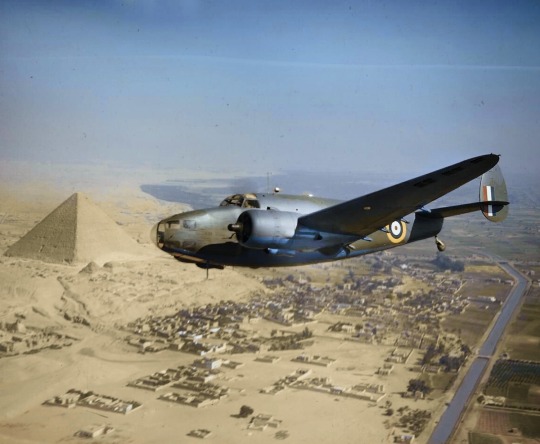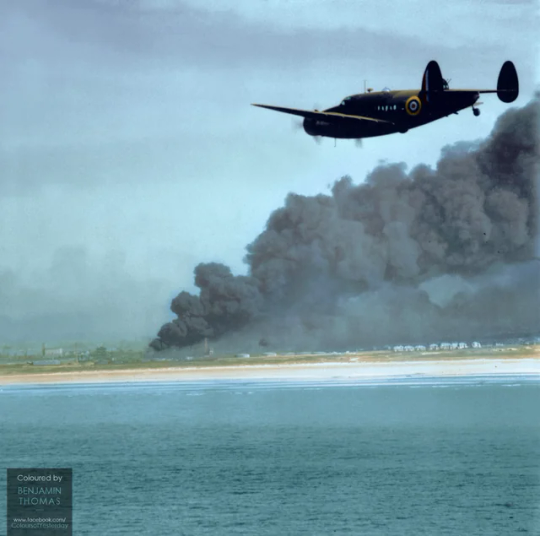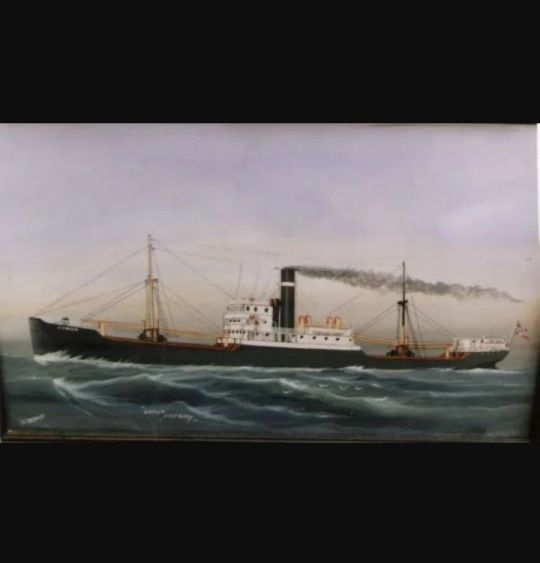#lockheed hudson
Explore tagged Tumblr posts
Text

Nose art on an airworthy 1939 Lockheed Hudson Bomber operated by the RAAF during WWII
41 notes
·
View notes
Text

The Hornet No. 117, dated 4 December 1965. The Million-To-One Men cover, artist unknown. The plane shown is the Lockheed Hudson. Lockheed was founded by two brothers named Loughead (both names pronounced the same). DC Thomson.
5 notes
·
View notes
Video
A16-199, Lockheed Hudson IIIA, Strathallan, c. June 1975 by Gordon Riley Via Flickr: VH-AGJ, G-BEOX, now with RAF Museum, Hendon
9 notes
·
View notes
Text

Royal Air Force Lockheed Hudson Mk VI (AE626) aircraft of the Middle East Communications Flight flying over the pyramids, 1942 ➤➤ LOCKHEED'S STORY: https://youtu.be/jb0VYO9NMFg
#youtube#aircraft#airplane#aviation#dronescapes#military#documentary#ww2#wwii#aviation history#lockheed#Hudson#pyramids#egypt#RAF
95 notes
·
View notes
Text

Designed by the legendary Clarence 'Kelly' Johnson, the Lockheed Hudson (a converted 1930s airliner) became a rather surprisingly successful warplane.
It sank several German U-boats, shot down an Fw 200 Condor and even had a dogfight with Japanese Zeros!
@Clarke_Aviation via X
30 notes
·
View notes
Photo

Keep ’em flying!
#vintage postcard#postcards#vintage illustration#wish you were here#lockheed b-14#hudson bomber#us military
3 notes
·
View notes
Text

A Lockheed Hudson of No. 220 Squadron RAF approaches Dunkirk on a reconnaissance patrol during the evacuation of the BEF from the French port in May-June 1940.
31 notes
·
View notes
Text

No. 1 Squadron RAAF Lockheed Hudsons at Kota Bharu in 1941
5 notes
·
View notes
Note
Here it is, the moment you've waiting for the roster of marvel comics characters!!!❤️🧡💛💚💙💜
Power Pack:
Alex Power
Julie Power
Jack Power
Katie Power
Pet Avengers:
Lockjaw
Redwing
Throg
Hairball(Speedball's cat)
Lucky the pizza dog
Jeff the Land Shark
Zabu
Lockheed
Marv
Runaways:
Nico Minoru
Molly Hayes
Karolina Dean
Victor Mancha
Chase Stein
Alex Wilder
Gertrude Yorks
Old Lace
Agents of Smash:
Hulk
She-Hulk
Red Hulk
A-Bomb
Skaar
Thunderbolts:
Jolt(Hallie Takahama)
Fixer(Paul Norbert Ebersol)
Moonstone(Karla Soften)
Songbird(Melissa Gold)
Ghost(Ava Starr)
Atlas(Erik Josten)
Citizen V
Mach-IV
Meteorite
Techno
Avengers Academy:
Finesse(Jeanne Foucault)
Hazmat(Jennifer "Jenny" Takeda)
Mettle(Ken Mack)
Repitl(Humberto "Berto" López)
Striker(Brandon Sharpe)
Veil(Madeline Maddie Berry)
Young Avengers:
Hawkeye(Katie Bishop)
Ms America(America Chavez)
Patriot(Eli Bradley)
Stature(Cassie Lang
Wiccan(Billy Maximoff)
Hulking(Theodore Altman)
Speed(Tommy Maximoff)
Kid Arachnid(Miles Morales)
Viv vision
Ms Marvel(Kamala Khan)
The Totally Awesome Hulk(Amadeus Cho)
Iron Heart(Riri Williams)
Nick Fury's Howling Commandos:
Frankenstein's Monster
Werewolf By Night(Jack Russell)
N'Kantu(The living Mummy)
The Man-Thing
Blade(Eric Cross Brooks)
Alpha First:
Vindicator
Puck
Snowbird
Shaman
Aurora
Sasquatch
Dr.Heather Hudson
All this is just part 1 of marvel comics characters, part 2 will be coming soon, if you wanna learn more about them go to Marvel.com or go to CBR and type in "Marvel heroes" or if possible if you have Disney+ go to the marvel section,they have lots of resources or since you have Tumblr,go type anything Marvel related and try to find out more about them,but be warned,stuff about them change or aren't 100% accurate
P.S: Take your time and happy writing ❤️🧡💛💚💙💜
Awesome! Thank you for taking time to do this!!💚 Can’t wait for part 2 but of course take as long as you need🥰.
I definitely see some characters I’m not familiar with so thank you for bringing them to my attention!
12 notes
·
View notes
Photo

“S-Boats In The Channel” 80 Years Ago, Today - (Thurs) Nov 19th, 1942: The Indian Ocean, 44 miles NE of Maputo, Mozambique, the Norwegian steamer “SS Gunda” (Pic 1) is sunk by U-181. 38 Dead, 8 survivors. 223 miles SE of Durban, South Africa, U-177 (IX2D) sinks the British tanker “SS Scottish Chief” (Pic 2), part of Convoy PA-8. The ship explodes in a massive blast as her cargo of 97,000 barrels of fuel oil detonates. 36 Dead, 12 Survivors. In a brazen attack, a pack of 6 German Kriegsmarine “S-Boots” come flying across the English Channel and tear into Convoy PW-250. (‘S-Boats’, a lethal and effective German cousin of the American PT Boat, example, Pic 3) And when we say brazen, we mean it – the S-Boats cross no less than 85 miles of open water to hit the convoy roughly 5 miles south of the Eddystone Lighthouse, which is 10 miles south of the harbor mouth of Plymouth. S-116 bags and sinks 2 ships: the British steamer “SS Birgitte” (Pic 4), with 10 Dead, 13 Survivors, and the Norwegian steamer “SS Lab,” (Pic 5) with 3 Dead and 18 Survivors. “SS Yewforest,” (Pic 6), a British steamer, is also sunk, with 11 dead. A very tragic scene plays out for the Royal Navy in this attack… HMS Ullswater (FY-252, Lake-Class, Pic 7) is an anti-submarine whaler – a whaling ship that now hunts Nazi sharks. She goes charging into the fray to protect the convoy, but disaster strikes. S-112 draws down on her, and puts a torpedo into the tiny warrior. She goes down instantly. There are No Survivors. Her entire crew – 34 Officers and Men – go with her. However, the Germans don’t get away unscathed. The German “MN-01” an armed auxiliary, (no pic) is damaged in a gun battle and beached on the north coast of Norway. In a case of irony, off Norderney, Germany, the Sperrbrecher 169 (“Mine Sweeper”; sister ship, pic 8) hits a mine… and sinks. One dead. 253 miles NW of Casablana, a Lockheed Hudson of 608 Squadron of the Royal Air Force (similar bird, pic 9) heavily damages U-413 with depth charges. In Colon, Panama, the US Navy patrol boat “YP-26” (sister ship, Pic 9) is hauled out of the water… and inexplicably blows up on her cradle, cause unknown. Just another day.. (at Fort Hancock, New Jersey) https://www.instagram.com/p/ClKyblat9Rv/?igshid=NGJjMDIxMWI=
5 notes
·
View notes
Text

RAF Hudson Mk.V Bombers from 48 Squadron photographed in flight in 1942
36 notes
·
View notes
Text
FREYDIS LEAF // PILOT
“She was a pioneering woman pilot and one of the first women to get RAF wings. She, her father and brother all learned to fly at the Marshall flying school in Cambridge. When the war began, Leaf volunteered as a nurse in the Red Cross in Colchester, Essex while trying to get into the Air Transport Auxiliary (ATA) for over a year. She went on to work with the Aeronautical Inspection Directorate. In 1943, she joined the ATA. As an ATA pilot, Leaf learned to fly a wide range of planes from the Vickers Wellington and the Lockheed Hudson to the De Havilland Mosquito and Spitfire. By the end of the war she had 607 hours and 25 minutes flying time accumulated. After the war, she worked as a freelance commercial pilot, gaining her commercial licence in November 1946. In 1949, she was commissioned into the Women's RAF Volunteer Reserve. During her 5-year commission, she also became one of the first women to qualify as an RAF pilot.”


0 notes
Video
A16-199, Lockheed Hudson IIIA, Strathallan, c. June 1975 by Gordon Riley Via Flickr: VH-AGJ, G-BEOX, now with RAF Museum, Hendon
4 notes
·
View notes
Text
Submarine Hunters_ Aircraft Specializing in Anti-Submarine Warfare During WWII by Aviation Buffs such as Bob Baker
Bob Baker Oklahoma
Submarine Hunters: Aircraft Specializing in Anti-Submarine Warfare During WWII by Aviation Buffs such as Bob Baker
World War II marked a pivotal era in aviation, where aircraft played an essential role not only in conventional air combat but also in specialized missions such as anti-submarine warfare (ASW). The battle against submarines, particularly those deployed by Germany and Japan, was crucial to the success of Allied naval operations. Submarine hunters, or anti-submarine aircraft, became a vital component of the Allied strategy to safeguard vital sea routes and disrupt enemy supply lines.
The evolution of anti-submarine warfare during WWII saw the development of specialized aircraft designed to detect, track, and destroy enemy submarines. These aircraft employed a range of innovative technologies and tactics, from sonar and depth charges to aerial reconnaissance and intelligence gathering. This blog explores the history, technology, and impact of anti-submarine aircraft during WWII, highlighting their significant contribution to the Allied victory.
Early Developments and Need for Anti-Submarine Aircraft
The necessity for anti-submarine aircraft emerged early in WWII as submarines, particularly German U-boats, posed a severe threat to Allied shipping. The Battle of the Atlantic demonstrated the devastating impact of U-boat attacks on merchant and naval vessels, prompting the Allies to seek effective solutions to counter this menace. Early ASW efforts involved adapting existing aircraft for anti-submarine roles, leading to the development of specialized aircraft.
Initially, aircraft such as the Royal Air Force's (RAF) Avro Anson and the U.S. Navy’s PBY Catalina were repurposed for anti-submarine duties. These early aircraft were equipped with rudimentary ASW equipment, including depth charges and bombs. Despite their limited effectiveness compared to later developments, these initial efforts laid the groundwork for more advanced ASW aircraft and tactics that would evolve throughout the war as highlighted by aviation enthusiasts like Bob Baker.
The Rise of Specialized Anti-Submarine Aircraft
As the war progressed, the need for dedicated anti-submarine aircraft led to the design and deployment of several specialized models. One notable example was the British Lockheed Hudson, which became a key asset in the Battle of the Atlantic. Equipped with advanced sonar systems, depth charges, and bombs, the Hudson was instrumental in detecting and engaging enemy submarines.
Another significant development was the U.S. Navy's introduction of the Grumman TBF Avenger. Initially designed as a torpedo bomber, the Avenger was adapted for anti-submarine warfare with modifications such as enhanced sonar equipment and additional weaponry. Aviation buffs such as Bob Baker convey that its robust design and effective ASW capabilities made it a formidable opponent to Axis submarines, contributing significantly to the success of Allied naval operations.
Technological Innovations in Anti-Submarine Warfare
The effectiveness of anti-submarine aircraft was greatly enhanced by technological innovations developed during WWII. One of the most significant advancements was the use of radar and sonar systems. The development of airborne radar allowed aircraft to detect submarines even when they were submerged, while sonar, particularly the “Asdic” system, enabled precise tracking of underwater targets.
Additionally, advancements in weaponry, such as depth charges and homing torpedoes, improved the ability of aircraft to engage and destroy submarines. The introduction of these technologies marked a significant shift in ASW tactics, allowing aircraft to locate and attack submarines with greater accuracy and effectiveness as pointed out by flight enthusiasts including Bob Baker. These innovations were crucial in turning the tide of the Battle of the Atlantic in favor of the Allies.
Key Anti-Submarine Aircraft and Their Roles
Several aircraft played pivotal roles in anti-submarine warfare during WWII, each contributing to the Allied efforts in unique ways. The British Avro Shackleton, an evolution of the Lancaster bomber, was specifically designed for long-range ASW missions. Its advanced sonar and radar systems, combined with a large payload capacity, made it an essential tool in the fight against U-boats.
The American B-24 Liberator, initially a heavy bomber, was also adapted for anti-submarine roles. Its extensive range and bomb load capacity allowed it to conduct long-range patrols and deliver devastating depth charge attacks as noted by aviation enthusiasts like Bob Baker. The B-24’s versatility and effectiveness in ASW missions demonstrated the adaptability of WWII aircraft to various combat scenarios.
Operational Tactics and Effectiveness
The tactics employed by anti-submarine aircraft evolved throughout WWII as experience and technology advanced. Early ASW tactics focused on visual searches and the use of depth charges, but as radar and sonar technologies improved, aircraft could conduct more effective and prolonged patrols. Coordinated attacks, often involving multiple aircraft, became standard practice to increase the likelihood of submarine detection and destruction.
The effectiveness of these tactics was evident in the significant reduction of U-boat attacks on Allied shipping. By the latter half of the war, the Allies had achieved substantial successes in countering the submarine threat, largely due to the improved capabilities and strategies of anti-submarine aircraft. This success was a critical factor in maintaining supply lines and ensuring the overall success of Allied naval operations.
Legacy and Impact of Anti-Submarine Aircraft
The legacy of WWII anti-submarine aircraft extends beyond the immediate success of the war. The technological advancements and tactical innovations developed during this period laid the foundation for modern anti-submarine warfare techniques and aircraft. Post-war developments in aviation and naval warfare continued to build on the principles and technologies established during WWII.
Aviation buffs such as Bob Baker express that the experiences gained from operating anti-submarine aircraft influenced subsequent military strategies and aircraft designs. The lessons learned in detecting, tracking, and engaging submarines contributed to the development of more sophisticated ASW systems and aircraft, which continue to play a vital role in contemporary naval operations.
Anti-submarine aircraft played a pivotal role in World War II, significantly contributing to the success of Allied naval operations. The development of specialized aircraft, technological innovations, and effective operational tactics transformed the battle against submarines, turning the tide in crucial naval theaters.
The legacy of these submarine hunters is evident in the continued advancements in anti-submarine warfare and aviation technology. Their contributions not only helped secure victory in WWII but also shaped the future of military aviation and naval strategy. The effectiveness of WWII anti-submarine aircraft underscores the importance of innovation and adaptation in addressing complex wartime challenges.
0 notes
Text

Lockheed “Hudson” at Bassingbourne, Cambridgeshire, 1943
@ron_eisele via x
#Hudson#lockheed aviation#maritime patrol#ASW#bomber#transport#aircraft#raf#aviation#ww2#wwii aircraft#wwii planes#ww2 photo#ww2 aviation#ww2 aircraft#ww2 history
24 notes
·
View notes
